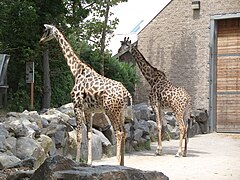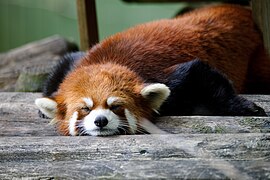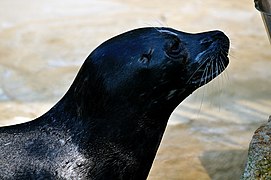Roger Williams Park Zoo
History
The Roger Williams Park Zoo first opened in 1872 as a limited collection of small animals, including raccoons, guinea pigs, mice, squirrels, rabbits, hawks, peacocks, and anteaters. Its first building was the Menagerie which opened in 1890. In the 1900s, the facility began to spread out over the entire park, featuring a variety of animals such as monkeys, hoofstock, bears, and big cats. In 1929, the Menagerie building was converted to a birdhouse; this was followed by the opening of an elephant barn in 1930 (which would later be converted to the Tropical America building). In the 1930s, a new sea lion pool was constructed. Bunny Village opened in 1949, one of the zoo's most popular exhibits.
In the mid-1960s, the zoo started to show signs of neglect. In 1962, Sophie Danforth founded the Rhode Island Zoological Society to increase public awareness of the neglect and to raise funds for improvement, and it remains the organization that supports and manages the zoo. The society opened a gift shop and food concessions in 1970, and all funds benefited the zoo. The zoo closed from 1978 to 1980 to undertake an upgrade project. A children's nature center was added, as well as a naturalistic polar bear exhibit, a boardwalk through a wetlands area, and a North American bison exhibit. In the 1980s, a South American Pampas exhibit and a lemur exhibit were built. In 1986, the zoo's old stable/barn - which for many years had been home to the park's workhorses - was converted into an animal hospital, education department, and administrative offices. As a result, the zoo became the first in New England to receive accreditation from the Association of Zoos and Aquariums.
In 1987, a new master plan was formulated to dramatically expand the zoo. Over time, many new exhibits were built, including a new sea lion exhibit (1987), a Humboldt penguin exhibit (1988), Plains of Africa (1991–93), Madagascar (1995), and Marco Polo Trail (1996). In 1989, the old Menagerie building was once again renovated, this time into a new gift shop. A new veterinary hospital opened in the spring of 2011. Hasbro's Our Big Backyard opened in 2012 as an interactive play space, with a second phase completed in 2014 featuring native New England animals. In the summer of 2012, the zoo opened new exhibits for takins, red river hogs, and king vultures.
A new master plan was unveiled in 2015 for the next 20 years. It includes constructing a new rainforest building to be completed in 2018, a new exhibit for California sea lions and Humboldt penguins, a shorebird aviary, and a new tiger habitat. A complete reworking of the North America exhibit will feature grizzly bears, moose, and bighorn sheep.
Animals and exhibits


The zoo is home to more than 150 rare and fascinating animals from around the world. Major exhibits at the zoo include:
- Alex and Ani Farmyard: opened in 2014. It serves as a petting zoo where visitors can feed the animals food provided by the zoo. It primarily features domesticated fauna such as Flemish Giant rabbits, Guinea hogs, Huacaya alpacas, mini Nubian goats, a miniature donkey, Shetland sheep, and various chicken breeds. It also features wildlife closely associated with farmland, such as barn owls. There are also interactive stations meant to mimic life on a farm, which are sponsored by the local businesses Munroe Dairy, Little Rhody Farms, and Bank RI.
- Fabric of Africa: opened in April 1991, expanded in 1993, and renovated in 2008. It is the exhibit closest to the zoo's entrance. It features species indigenous to Africa, including Aldabra giant tortoises, Ankole-Watusi cattle, common ostriches, cheetahs, plains zebras, black crowned cranes, red river hogs, and blue wildebeest. It also contains Jambo Junction.
- Jambo Junction: features African bush elephants and Masai giraffes. Visitors can learn more about how the zoo cares for these large animals in the Elephant & Giraffe Pavilion, an indoor component of Jambo Junction. It is the only zoo in New England that contains African elephants, which occupy a 13,500 sq. ft. (1,254.191 sq. meters) enclosure. Though the three elephants they have are all females, the zoo plans to acquire a male in the near future so that they may breed. The Fabric of Africa was renovated in 2008 to revamp Jambo Junction, specifically to better accommodate the elephants. Jambo Junction is sponsored by the Robert F. Stoico/FIRSTFED Charitable Foundation and Textron.
- Faces of the Rainforest: A state-of-the-art building first opened in 2018 for neotropical life featuring a free-flight aviary, cascading waterfall, open concept primate habitat and more. Animals in and around the building include black howler monkeys, Bolivian gray titis, Chilean flamingos, dyeing poison dart frogs, giant anteaters, giant otters, golden lion tamarins, green anacondas, hyacinth macaws, keel-billed toucans, Linnaeus's two-toed sloths, scarlet ibises, southern tamanduas, white-faced sakis, yellow-banded poison dart frogs, and yellow-rumped caciques.
- Feinstein Junior Scholar Wetlands Trail: a walk through area that reflects the natural wetland environments of Rhode Island, which are becoming increasingly rarer as the state continues to be urbanized. All wildlife is indigenous to Rhode Island, and while the animals are protected by the zoo they are not the property of them. It is known to feature Canada geese, great blue herons, several species of freshwater fish and turtles, and wood ducks. The trail is sponsored by the Feinstein Junior Scholar through the local Feinstein Foundation. There is also an exhibit for Reeves's muntjacs at the start of the trail.
- Himalayan Trek: opened in 1996 under the name Marco Polo's Adventure Trek (the name was changed in 2024). It is one of two areas to focus on animals from Asia. It features fauna encountered (or likely to have been encountered) by the explorer Marco Polo, including Bactrian camels, moon bears, red-crowned cranes, red pandas, Sichuan takins, and snow leopards.
- Wild Woodlands (formerly called North America until 2024): features American bison, bald eagles, black vultures, golden eagles, North American porcupines, northern copperhead snakes, pronghorns, red wolves, timber rattlesnakes, turkey vultures and wild turkeys. The harbor seals can be viewed through an underwater window.
- Our Big Backyard: an interactive live play space for children and families. The exhibit promotes outdoor, free-ended play. The playspace is funded by the toy company Hasbro and the pharmaceutical company CVS Health. There is also an aviary for common ravens.
- World of Adaptations (formerly Australasia): it features animals primarily from Southeast Asia and Oceania, including Australian snake-necked turtles, Bali mynas, Bennett's wallabies, eastern rosellas, Indian peafowl, king vultures, Komodo dragons, laughing kookaburras, Matschie's tree kangaroos, North American river otters, North Sulawesi babirusa, northern white-cheeked gibbons, Palawan binturongs, radiated tortoises and wrinkled hornbills. The Komodo dragon at the zoo is the first of its kind in New England.
Gallery
-
Zebras.
-
Goat at the petting zoo.
-
Red panda (Ailurus fulgens).
-
Harbor seal (Phoca vitulina).
-
One of the many flowering plants at the zoo.
See also
References
- ^ "Roger Williams Park Zoo - Providence, Rhode Island - Zoo and Wildlife Conservationists". city-data.com. City-Data. Retrieved August 19, 2010.
- ^ "History of Roger Williams Park Zoo". rogerwilliamsparkzoo.org. Roger Williams Park Zoo. Retrieved August 19, 2010.
- ^ "Currently Accredited Zoos and Aquariums". aza.org. AZA. Retrieved October 27, 2012.
- ^ "U.S. News: Roger Williams Park Zoo among Top 26 in nation". Providence Business News.
- ^ Craig, Kris. "Dinnertime at Roger Williams Park Zoo". The Providence Journal.
- ^ Perry, Jack. "Roger Williams Park Zoo rebounds from COVID shutdown with record turnout". The Providence Journal.
- ^ "Zoo abandons plans for polar bear exhibit". turnto10.com. NBC 10 News. Archived from the original on April 15, 2012. Retrieved April 4, 2012.
- ^ "Plan for Roger Williams Park Zoo includes Rainforest, new animals". turnto10.com. NBC 10 News. Retrieved August 3, 2015.
- ^ "Master Plan". rwpzoo.org. Roger Williams Park Zoo. Retrieved August 3, 2015.
- ^ Animals on exhibit | Roger Williams Park Zoo rwpzoo.org Roger Williams Park Zoo. Retrieved May 4, 2020
- ^ Hill, John (June 7, 2014). "Elephants remain big draw at Roger Williams Park Zoo". The Providence Journal.
- ^ "What We Do: Roger Williams Park Zoo". Robert F. Stoico/FIRSTFED Charitable Foundation.
- ^ "RWPZ 2024 guest map 8.5x11 no border-dragons" (PDF).
- ^ "Roger Williams Park Zoo". Destination 360.
- ^ "Komodo Dragon". ripr.org. RI Public Radio. Retrieved May 19, 2017.









